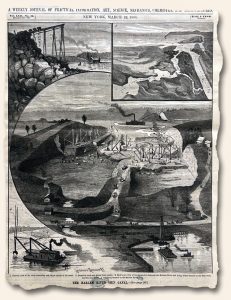Scientific American & the Harlem River… 1890…
February 11, 2022 by Stephanie Williams  Email This Post
|
Email This Post
|  Print This Post
Print This Post
Growing up less than 50 miles from NYC, it was a regular occurrence for “us kids” to reach as far forward in the car as we could to be the first of the family to pass the paint mark on the Lincoln Tunnel walls delineating the New York/New Jersey boundary. Along with the iconic skyline and the Statue of Liberty, tunnels and bridges defined the vista of any excursion to Manhattan.
 Today’s jaunt into the Scientific American reminded me of those childhood outings and had me scouring old maps to discern the changes wrought in the waterway systems for the development of metropolitan New York. This publication, filled with inventions and botanical discoveries, also chronicles the many arenas of civil engineering foresight and ingenuity. Those examples of “aging infrastructure” so hotly debated in the political arena of today, were the marvels of yesterday. Without computer models, before construction vehicles, absent the communication methods of today, great changes were made to the natural landscape in order to accommodate the iconic center of commerce.
Today’s jaunt into the Scientific American reminded me of those childhood outings and had me scouring old maps to discern the changes wrought in the waterway systems for the development of metropolitan New York. This publication, filled with inventions and botanical discoveries, also chronicles the many arenas of civil engineering foresight and ingenuity. Those examples of “aging infrastructure” so hotly debated in the political arena of today, were the marvels of yesterday. Without computer models, before construction vehicles, absent the communication methods of today, great changes were made to the natural landscape in order to accommodate the iconic center of commerce.
An article in the March 22, 1890, Supplement to Scientific American describes “The Harlem River Improvement and Ship Canal” — a project that lasted thirteen years and cost over $200,000. Many political, geological, and legal difficulties are described, along with evaluation of decisions made, as well as alternate proposed solutions. The detail is fascinating, even to someone who has no understanding of the impact rivers and railroads have on commerce and industry. In fact, it never occurred to me that rivers are moved, straightened or even deepened in order to make them more useful. And I wonder what today’s civil engineers think of the building strictures from over one hundred years ago.
The laws of May 20, 1879, provides that all bridges hereafter to be constructed over this channel shall be at right angles to its courses, and that the bridges at the draws shall not be less than 24 feet above high water of spring tide, and that no tunnel shall be constructed under it which will not permit the excavation of a 20-foot channel.
If you liked this post, you may also enjoy...
- Before there was the Chunnel…
- Still Learning… The Scientific American & the Cost of Cotton…
- Wish I had one of these…
- Same concern over 100 years ago…
- Rare Newspapers found on the National Geographic Channel…
Comments
Feel free to leave a comment...
and oh, if you want a pic to show with your comment, go get a gravatar!


